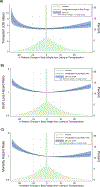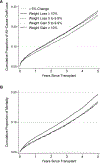Association Between Weight Loss Before Deceased Donor Kidney Transplantation and Posttransplantation Outcomes
- PMID: 31126666
- PMCID: PMC6708783
- DOI: 10.1053/j.ajkd.2019.03.418
Association Between Weight Loss Before Deceased Donor Kidney Transplantation and Posttransplantation Outcomes
Abstract
Rationale & objective: There is debate on whether weight loss, a hallmark of frailty, signals higher risk for adverse outcomes among recipients of deceased donor kidney transplantation (DDKT).
Study design: Retrospective cohort study.
Setting & participants: Using national Organ Procurement and Transplantation Network data, we included all DDKT recipients in the United States between December 4, 2004, and December 3, 2014, who were adults (aged ≥ 18 years) when listed for DDKT.
Exposures: Relative pre-DDKT weight change as a continuous predictor and categorized as <5% weight change from listing to DDKT, ≥5% to <10% weight loss, ≥10% weight loss, ≥5% to <10% weight gain, and ≥10% weight gain.
Outcomes: We examined 3 post-DDKT outcomes: (1) transplant hospitalization length of stay (LOS) in days, (2) all-cause graft failure, and (3) mortality.
Analytic approach: Unadjusted fractional polynomial methods, multivariable log-gamma models, and multivariable Cox proportional hazards models.
Results: Among 94,465 recipients of DDKT, median pre-DDKT weight change was 0 (interquartile range, -3.5 to +3.9) kg. There were nonlinear unadjusted associations between relative pre-DDKT weight loss and longer transplant hospitalization LOS, higher all-cause graft loss, and higher mortality. Compared with recipients with <5% pre-DDKT weight change (n = 49,366; 52%), recipients who lost ≥10% of their listing weight (n = 10,614; 11%) had 0.66 (95% CI, 0.23-1.09) days longer average transplant hospitalization LOS (P = 0.003), 1.11-fold higher graft loss (adjusted HR [aHR], 1.11; 95% CI, 1.06-1.17; P < 0.001), and 1.18-fold higher mortality (aHR, 1.18; 95% CI, 1.11-1.25; P < 0.001) independent of recipient, donor, and transplant factors. Pre-DDKT dialysis exposure, listing body mass index category, and waiting time modified the association of pre-DDKT weight change with hospital LOS (interaction P < 0.10), but not with all-cause graft loss and mortality.
Limitations: Unmeasured confounders and inability to identify volitional weight change. Also, the higher significance level set to increase the power of detecting interactions with the fixed sample size may have resulted in increased risk for type 1 error.
Conclusions: DDKT recipients with ≥10% pre-DDKT weight loss are at increased risk for adverse outcomes and may benefit from augmented support post-DDKT.
Keywords: Renal transplantation; deceased donor kidney transplantation (DDKT); end-stage kidney disease (ESKD); frailty; graft failure; mortality; obesity; outcomes; protein-wasting malnutrition; sarcopenia; wasting; weight loss.
Copyright © 2019 National Kidney Foundation, Inc. Published by Elsevier Inc. All rights reserved.
Figures



References
-
- Kim JC, Kalantar-Zadeh K, Kopple JD. Frailty and protein-energy wasting in elderly patients with end stage kidney disease. Journal of the American Society of Nephrology : JASN 2013;24(3):337–351. - PubMed
-
- Amparo FC, Cordeiro AC, Carrero JJ, et al. Malnutrition-inflammation score is associated with handgrip strength in nondialysis-dependent chronic kidney disease patients. Journal of renal nutrition : the official journal of the Council on Renal Nutrition of the National Kidney Foundation 2013;23(4):283–287. - PubMed

